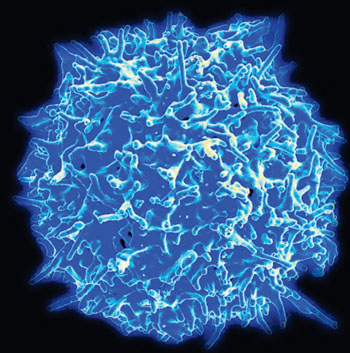High T-Cell Counts Make Better Match for Stem-Cell Transplants
By LabMedica International staff writers
Posted on 01 Jul 2015
A simple blood test that measures the T lymphocyte count in donors for stem cell transplants may help identify the best match for patients in need of an allogeneic stem cell transplant.Posted on 01 Jul 2015
Older individuals with blood cancers are often treated with reduced-intensity allogeneic stem cell transplants, in which the chemotherapy or radiation dose is reduced, resulting in fewer side effects for patients.

Image: Scanning electron micrograph of a human T lymphocyte (also called a T cell) from the immune system of a healthy donor (Photo courtesy of The National Institute of Allergy and Infectious Diseases).
Scientists at the University of Pennsylvania Perelman School of Medicine (Philadelphia, PA, USA) retrospectively evaluated associations between T cell doses present in the transplant graft and outcomes in 200 patients from the Abramson Cancer Center (ACC) at the University with blood cancers such as acute myeloid leukemia, myelodysplastic syndrome, non-Hodgkin lymphoma, and others. Knowing that CD8 cells can kill cancer cells, while CD4 cells help suppress or regulate immune responses, the investigators examined these two types of T-cells closely and found that the numbers of CD8 cells in the stem-cell graft had a dramatic impact on survival. They also found that high CD8 cell counts were much more common among young donors.
To characterize the CD34 and T cell doses, 10 × 106 cells were removed from the peripheral blood stem-cell (PBSC) product prior to the infusion and cell content was analyzed by flow cytometry. The doses of CD3, CD4 and CD8 cells were determined by flow cytometry conducted on FACSCanto flow cytometer (BD Biosciences; San Jose, CA, USA) using antibodies against CD45, CD3, CD4 and CD8. Higher CD8 cell doses were associated with a lower risk for relapse and improved relapse-free survival and overall survival without a significant increase in graft-versus-host disease or nonrelapse mortality. A cutoff level of 0.72 × 108 CD8 cells/kg optimally segregated patients receiving CD8hi and CD8lo grafts with differing overall survival. Donor age inversely correlated with graft CD8 dose and consequently, older donors were unlikely to provide a CD8hi graft, whereas approximately half of younger donors provided CD8hi grafts.
The four-year overall survival rates were 59% for younger, unrelated donor grafts with high CD8 counts, 18% for younger, unrelated donor grafts with low CD8 counts, and 33% for older, human leukocyte antigen (HLA)-matched sibling donor grafts . This suggests it would be better to use a younger unrelated donor graft with high CD8 cells instead of an older sibling donor. Additionally, the CD8 cell content of the graft could be predicted by measuring the proportion of CD8 cells in a blood test from potential stem cell donors, providing a simple way to screen for the best donor even before the stem cell graft was collected.
Ran Reshef, MD, an assistant professor at ACC and lead author of the study, said, “There may be suitable donors out there who are overlooked because they are considered a poorer match by today’s donor selection algorithms. Refining the screening method could greatly increase the chances of finding the most appropriate donor, one that will induce the most potent graft-vs-tumor response. This is a method deserving additional investigation, which could refine the standardized matching system used by registries, such as Be the Match and others, and ultimately optimize the donor pool for older patients undergoing these transplants.” The study was published on June 8, 2015, in the Journal of Clinical Oncology.
Related Links:
University of Pennsylvania Perelman School of Medicine
BD Biosciences













